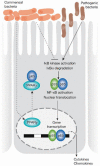The gut flora as a forgotten organ
- PMID: 16819463
- PMCID: PMC1500832
- DOI: 10.1038/sj.embor.7400731
The gut flora as a forgotten organ
Abstract
The intestinal microflora is a positive health asset that crucially influences the normal structural and functional development of the mucosal immune system. Mucosal immune responses to resident intestinal microflora require precise control and an immunosensory capacity for distinguishing commensal from pathogenic bacteria. In genetically susceptible individuals, some components of the flora can become a liability and contribute to the pathogenesis of various intestinal disorders, including inflammatory bowel diseases. It follows that manipulation of the flora to enhance the beneficial components represents a promising therapeutic strategy. The flora has a collective metabolic activity equal to a virtual organ within an organ, and the mechanisms underlying the conditioning influence of the bacteria on mucosal homeostasis and immune responses are beginning to be unravelled. An improved understanding of this hidden organ will reveal secrets that are relevant to human health and to several infectious, inflammatory and neoplastic disease processes.
Figures




References
-
- Abreu MT, Vora P, Faure E, Thomas LS, Arnold ET, Arditi M (2001) Decreased expression of Toll-like receptor-4 and MD-2 correlates with intestinal epithelial cell protection against dysregulated proinflammatory gene expression in response to bacterial lipopolysaccharide. J Immunol 167: 1609–1616 - PubMed
-
- Abreu MT, Fukata M, Arditi M (2005) TLR signaling in the gut in health and disease. J Immunol 174: 4453–4460 - PubMed
-
- Backert S, Selbach M (2005) Tyrosine-phosphorylated bacterial effector proteins: the enemies within. Trends Microbiol 13: 476–484 - PubMed
-
- Bairead E et al. (2003) Association of NOD2 with Crohn's disease in a homogenous Irish population. Eur J Hum Genet 11: 237–244 - PubMed
Publication types
MeSH terms
LinkOut - more resources
Full Text Sources
Other Literature Sources
Medical

